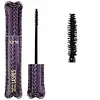What's inside
What's inside
 Key Ingredients
Key Ingredients

 Benefits
Benefits

 Concerns
Concerns

 Ingredients Side-by-side
Ingredients Side-by-side

Water
Skin ConditioningOryza Sativa Bran Wax
Skin ConditioningCyclopentasiloxane
EmollientHydrogenated Olive Oil Stearyl Esters
Emulsion StabilisingCopernicia Cerifera Cera
EmollientAlcohol Denat.
AntimicrobialPalmitic Acid
EmollientStearic Acid
CleansingCandelilla Cera
EmollientTriethanolamine
BufferingAcacia Senegal Gum
MaskingPanthenol
Skin ConditioningVp/Va Copolymer
Polyvinyl Alcohol
Aminomethyl Propanediol
BufferingChlorphenesin
AntimicrobialAscorbyl Palmitate
AntioxidantPhenoxyethanol
PreservativeCI 77499
Cosmetic ColorantWater, Oryza Sativa Bran Wax, Cyclopentasiloxane, Hydrogenated Olive Oil Stearyl Esters, Copernicia Cerifera Cera, Alcohol Denat., Palmitic Acid, Stearic Acid, Candelilla Cera, Triethanolamine, Acacia Senegal Gum, Panthenol, Vp/Va Copolymer, Polyvinyl Alcohol, Aminomethyl Propanediol, Chlorphenesin, Ascorbyl Palmitate, Phenoxyethanol, CI 77499
Water
Skin ConditioningCera Alba
EmollientEuphorbia Cerifera Wax
Polyester-5
Cetyl Alcohol
EmollientStearic Acid
CleansingPalmitic Acid
EmollientAcrylates/Octylacrylamide Copolymer
Vaccinium Myrtillus Fruit Juice
Skin ConditioningAminomethyl Propanediol
BufferingCaprylyl Glycol
EmollientCopernicia Cerifera Wax
Glyceryl Dibehenate
EmollientPhenoxyethanol
PreservativeSilica
AbrasiveEthylhexylglycerin
Skin ConditioningPropanediol
SolventXanthan Gum
EmulsifyingDisodium EDTA
Sodium Lauroyl Lactylate
EmulsifyingCellulose
AbsorbentHectorite
AbsorbentPEG-8
HumectantTocopherol
AntioxidantCeramide NP
Skin ConditioningCeramide AP
Skin ConditioningPhytosphingosine
Skin ConditioningCholesterol
EmollientCarbomer
Emulsion StabilisingAscorbyl Palmitate
AntioxidantAscorbic Acid
AntioxidantCitric Acid
BufferingCeramide EOP
Skin ConditioningCI 77499
Cosmetic ColorantWater, Cera Alba, Euphorbia Cerifera Wax, Polyester-5, Cetyl Alcohol, Stearic Acid, Palmitic Acid, Acrylates/Octylacrylamide Copolymer, Vaccinium Myrtillus Fruit Juice, Aminomethyl Propanediol, Caprylyl Glycol, Copernicia Cerifera Wax, Glyceryl Dibehenate, Phenoxyethanol, Silica, Ethylhexylglycerin, Propanediol, Xanthan Gum, Disodium EDTA, Sodium Lauroyl Lactylate, Cellulose, Hectorite, PEG-8, Tocopherol, Ceramide NP, Ceramide AP, Phytosphingosine, Cholesterol, Carbomer, Ascorbyl Palmitate, Ascorbic Acid, Citric Acid, Ceramide EOP, CI 77499
 Reviews
Reviews

Ingredients Explained
These ingredients are found in both products.
Ingredients higher up in an ingredient list are typically present in a larger amount.
We don't have a description for Aminomethyl Propanediol yet.
Ascorbyl Palmitate is created by combining pure Vitamin C and palmitic acid. It is an antioxidant and helps reduce hyperpigmentation.
This ingredient is a more stable version of Vitamin C, meaning it does not disintegrate as quickly when exposed to sunlight. However, studies show it does not penetrate skin as well as pure Vitamin C.
Ascorbyl Palmitate is oil soluble.
Read more about other types of Vitamin C:
Learn more about Ascorbyl PalmitateCi 77499 is also hydrated iron III oxide. It is created from mixing red and black iron oxides. This helps give shades of darkness to a product.
Iron III oxides are classified as inorganic chemicals for coloring.
Palmitic Acid is a fatty acid naturally found in our skin and in many plant and animal sources. In cosmetics, it is usually derived from palm oil. It serves many purposes in skincare, acting as a cleanser, emollient, and emulsifier.
As an emollient, palmitic acid helps soften and smooth the skin by preventing water loss. In cleansers, it helps remove oil and dirt while creating foam.
Its emulsifying properties help stabilize products by keeping water and oil-based ingredients from separating.
This may not be suitable for fungal acne-prone skin, as fatty acids like this can sometimes trigger breakouts in sensitive individuals.
Learn more about Palmitic AcidPhenoxyethanol is a preservative that has germicide, antimicrobial, and aromatic properties. Studies show that phenoxyethanol can prevent microbial growth. By itself, it has a scent that is similar to that of a rose.
It's often used in formulations along with Caprylyl Glycol to preserve the shelf life of products.
Stearic Acid is a fatty acid. It is an emollient, emulsifier, and texture enhancer.
As an emollient, stearic acid helps soften skin. It aids the skin's protective barrier by preventing water loss. It also provides a gentle cleansing effect without stripping away natural oils.
Stearic acid may also be used to enhance the texture of products. It can add volume and stabilize ingredients such as water and oil. This can help water and oil ingredients from separating.
Sources of stearic acid include animal or vegetable fats/oils such as coconut or shea. It can be naturally found in butter, cocoa butter, shea butter, vegetable fats, and animal tallow.
This ingredient may not be Malassezia folliculitis, or fungal-acne safe.
Learn more about Stearic AcidWater. It's the most common cosmetic ingredient of all. You'll usually see it at the top of ingredient lists, meaning that it makes up the largest part of the product.
So why is it so popular? Water most often acts as a solvent - this means that it helps dissolve other ingredients into the formulation.
You'll also recognize water as that liquid we all need to stay alive. If you see this, drink a glass of water. Stay hydrated!
Learn more about Water